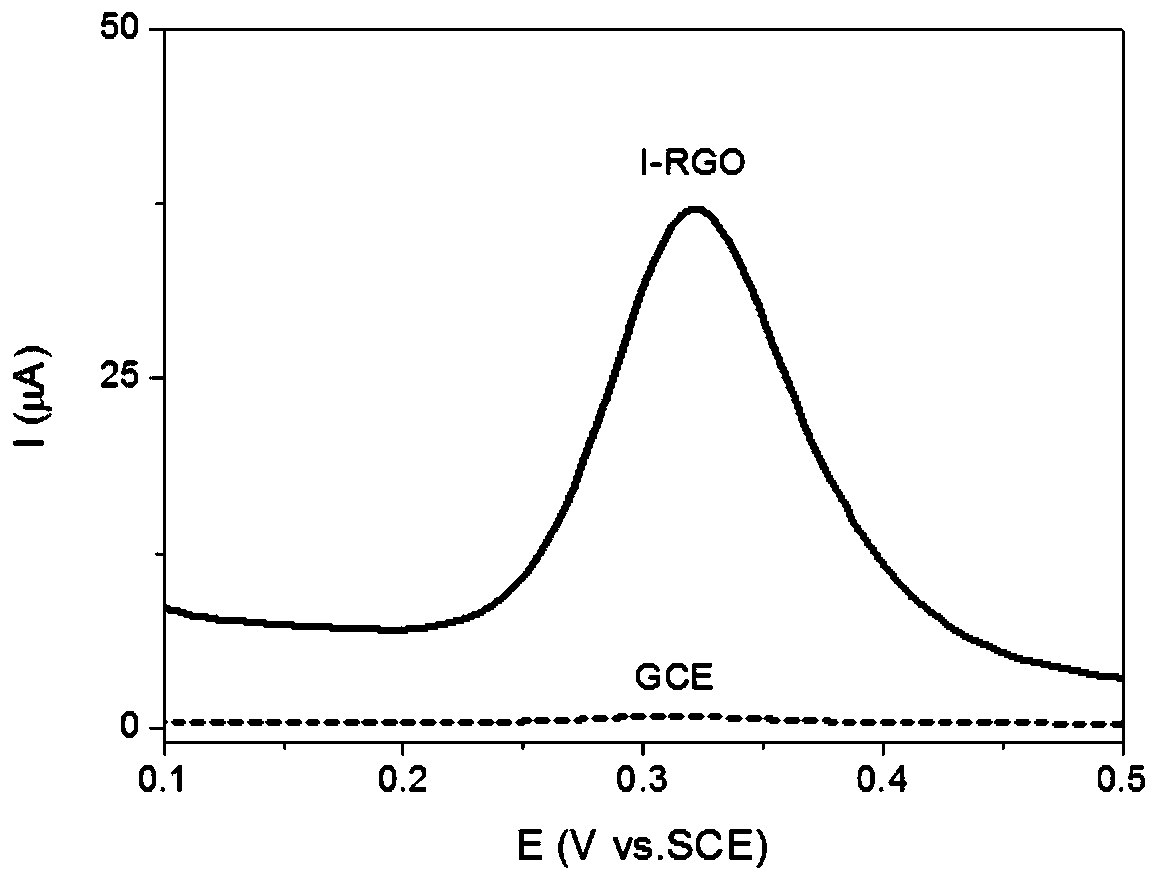Application of iodine doped graphene
A graphene and iodine doping technology, which is applied in the application field of element-doped graphene, can solve the problems of complex and expensive bisphenol A detection, and achieve the effects of stability, reusability, increased active area, and high sensitivity
- Summary
- Abstract
- Description
- Claims
- Application Information
AI Technical Summary
Problems solved by technology
Method used
Image
Examples
Embodiment 1
[0028] Preparation of graphene oxide:
[0029] Mix 0.5g of graphite powder with concentrated nitric acid (1.5mL) and concentrated sulfuric acid (15mL) in an ice-water bath, add 2g of potassium permanganate while stirring, then raise the temperature to 45°C for 1h. After adding 10 mL of deionized water to the reaction liquid for dilution, the temperature was raised to 90° C. for 1 h, cooled to room temperature, 5 mL of hydrogen peroxide was added, and the mixture was allowed to stand for stratification. After centrifugal separation, the obtained precipitate was washed three times with deionized water and three times with acetone, and then dried at 40° C. for 24 hours to obtain graphene oxide.
Embodiment 2
[0031] Preparation of iodine-doped graphene:
[0032] 60 mg of graphene oxide prepared in Example 1 was uniformly dispersed in 30 mL of deionized water by ultrasound, transferred to a 100 mL round bottom flask, added 3 mL of hydroiodic acid (55%), and heated in an oil bath at 85° C. for 24 h under nitrogen protection . The reaction solution was cooled to room temperature and then centrifuged. The resulting solid was washed three times with distilled water and three times with acetone, and dried in an oven at 40°C for 24 hours to obtain iodine-doped graphene. Passed TEM test ( figure 2 ) clearly observed the typical wrinkled structure of graphene materials, and I 3d peaks were clearly detected at 635 and 619eV in the XPS spectrum, which can be assigned to I 3d 3 / 2 and I 3d 5 / 2 peak( image 3 ), the iodine content is 0.3%. These results indicate that iodine-doped graphene has been successfully prepared.
Embodiment 3
[0034] Bisphenol A electrochemical sensing applications:
[0035] Weigh 2 mg of the iodine-doped graphene material prepared in Example 2 and ultrasonically disperse it uniformly in 1 mL of absolute ethanol, transfer 10 μL of the dispersion with a pipette gun and deposit it on the surface of the glassy carbon electrode, and dry it with an infrared lamp, that is get the working electrode. Using a saturated calomel electrode as a reference electrode, a platinum wire as an auxiliary electrode, and a phosphate buffer solution (10 μM) (pH=7.4) as a measurement medium, differential pulse voltammetry was used to measure the two Phenol A standard solution (10μM) was electrochemically scanned, and it can be seen that the iodine-doped graphene material has a significantly enhanced current intensity compared with the bare glassy carbon electrode (GC) ( figure 1 ), showing that the iodine-doped graphene material prepared by the present invention can improve the sensitivity of detection. ...
PUM
 Login to View More
Login to View More Abstract
Description
Claims
Application Information
 Login to View More
Login to View More - R&D
- Intellectual Property
- Life Sciences
- Materials
- Tech Scout
- Unparalleled Data Quality
- Higher Quality Content
- 60% Fewer Hallucinations
Browse by: Latest US Patents, China's latest patents, Technical Efficacy Thesaurus, Application Domain, Technology Topic, Popular Technical Reports.
© 2025 PatSnap. All rights reserved.Legal|Privacy policy|Modern Slavery Act Transparency Statement|Sitemap|About US| Contact US: help@patsnap.com



